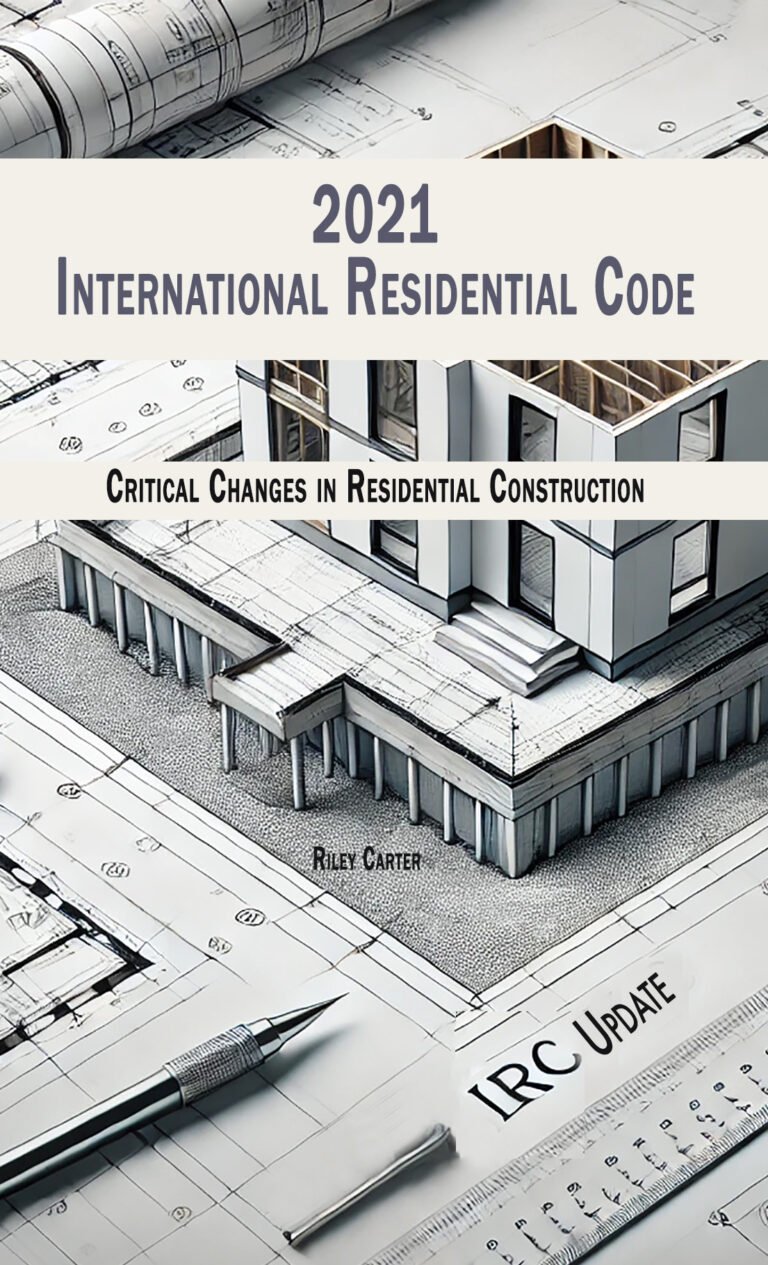Building codes don’t just change—they evolve. And for practitioners in the field, it’s not enough to know what changed. We need to understand why it changed, how it impacts construction sequences, and what it means for design integrity, budget planning, and long-term durability. 2021 IRC Updates offers a detailed, plain-language analysis of the latest residential code revisions, helping architects, builders, and inspectors move from compliance to confident application.

IRC 2021 Code Evolution and Practice.
A Technical Companion for Residential Design and Compliance
The 2021 International Residential Code introduces critical updates across structural design, fire safety, ventilation, and materials. From revised braced wall line locations and footing dimensions to emergency egress redefinitions and wind zone remapping, each change has cascading effects on layout, detailing, and construction logic. I’ve structured this book to highlight those ripple effects—comparing provisions from previous versions, offering implementation tips, and flagging areas where local amendments may come into play.
One of the more forward-looking aspects of this edition is its inclusion of alternative construction methods. Cob and 3D-printed structures—once the domain of fringe experimentation—now have a foothold in the code. This isn’t just bureaucratic housekeeping; it reflects a broader shift toward resilient, climate-responsive construction. In the book, I unpack the technical and regulatory implications of these inclusions and explore how they might scale responsibly.
This guide also breaks down electrical and mechanical updates with a focus on performance and safety. New mandates on surge protection, expanded GFCI coverage, and ventilation refinements all have design and cost consequences. Where possible, I connect code language to real-world project decisions, showing how the right early moves can prevent costly rework and ensure occupant well-being.
Ultimately, 2021 IRC Updates is written for professionals who take code literacy seriously—not just as a requirement, but as a tool for advancing better buildings. Whether you’re in plan review, on site, or in studio, this book offers a reference point you can return to—grounded in technical precision and shaped by the realities of modern residential practice.
Riley Carter
What Changed in the 2021 IRC—and Why It Matters
Building codes don’t just update—they evolve. Each edition of the International Residential Code (IRC) reflects a growing understanding of safety, performance, and real-world building practice.
The 2021 IRC introduces a series of strategic changes that go far beyond compliance checklists. These revisions affect how we design, sequence, and deliver residential buildings—from foundation to roofline. As a practitioner, knowing what changed isn’t enough. We need to know why it changed—and how those shifts ripple through structural detailing, energy efficiency, and inspection workflows.
This article summarizes the most impactful updates in the 2021 IRC, with practical guidance for architects, builders, engineers, and inspectors working in the field.
Structural Code Updates: Wall Bracing, Footings, and Load Paths
Revised Braced Wall Line Placement
One of the most critical structural changes involves braced wall lines. The 2021 IRC refines how we locate and define braced wall segments, especially in complex building shapes. This affects:
Minimum lengths of braced segments
Proximity of openings
Required detailing for continuous load paths
The result? You may need to revisit layouts that previously passed code under the 2018 version.
Footing Dimensions and Reinforcement
Revisions to footing depth and width reflect updated soil and load assumptions. Builders must now:
Adjust footing dimensions based on refined prescriptive tables
Consider soil classification more explicitly
Coordinate with rebar placement rules that now include bar overlap and anchoring clarifications

Fire and Egress: Evolving Safety Standards
Emergency Escape and Rescue Openings (EEROs)
The 2021 IRC redefines when and where emergency escape and rescue openings are required. This change impacts:
Basements converted to living space
Alterations to existing sleeping rooms
Situations where grading outside the window has changed
Designers need to verify compliant sill heights, clear openings, and access paths under the new provisions.
Fire Separation and Draftstopping
Updated tables and definitions affect fire separation walls, especially in two-family dwellings and townhomes. The 2021 code also clarifies when draftstopping is required in concealed floor spaces, with implications for truss framing and service routing.
Mechanical and Ventilation Revisions
Whole-House Mechanical Ventilation
Under the updated IRC Chapter 15, continuous mechanical ventilation becomes a clear requirement in more climate zones. The book emphasizes:
Minimum airflow rates based on ASHRAE 62.2 alignment
Fan efficiency and noise limitations
Controls that must be accessible and independent
This pushes designers to integrate mechanical systems earlier, especially in airtight homes using advanced framing or energy-efficient assemblies.

Energy and Envelope Adjustments
Thermal Envelope Tightening
While full energy code adoption varies by jurisdiction, the 2021 IRC reflects a direction toward tighter envelopes:
More aggressive U-factors for windows and doors
Insulation continuity and thermal bridging strategies
Air sealing details requiring better coordination between trades
These changes support the shift toward performance-based energy modeling, often cross-referenced with the 2021 IECC (International Energy Conservation Code).
Alternative Materials and Methods: A New Frontier
Perhaps the most forward-thinking change in the 2021 IRC is the formal recognition of alternative construction techniques, including:
Cob construction
3D-printed structural components
These inclusions mark a shift toward climate-responsive, low-carbon materials and open a dialogue between code officials and innovators. While not universally adopted, they create room for experimental architecture to transition into regulated building practice.
The book dissects these provisions with care, highlighting what’s allowed, under what testing regimes, and where local amendments may restrict or expand use.
Local Amendments and Jurisdictional Adoption
The IRC is a model code, which means adoption is jurisdictional. The article (and book) remind practitioners that:
Some regions lag behind, still using 2015 or 2018 editions
Others adopt selectively, modifying sections to fit local priorities
Coordination with AHJs (Authorities Having Jurisdiction) is essential
You’ll find side-by-side comparisons in the book showing where localized versions diverge from the national baseline—and how to document compliance accordingly.
A Code for Resilience, Not Just Compliance
The 2021 IRC doesn’t just patch old language—it reflects a deeper evolution in residential design:
Resilience to climate volatility
Responsiveness to new materials and technologies
Adaptation to changing household structures and performance expectations
As I explain in the book, understanding the technical logic behind code evolution empowers us to build safer, smarter, and more adaptable homes.
If you work in residential construction—whether as an architect, builder, inspector, or engineer—the 2021 International Residential Code is more than a legal document. It’s a roadmap to better buildings.
My goal with 2021 IRC Updates is not just to help you stay compliant, but to help you apply the code confidently, creatively, and with technical clarity.

